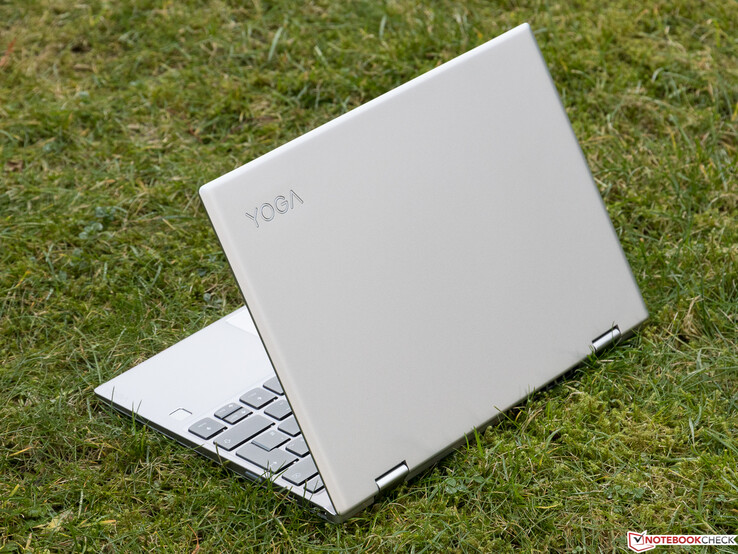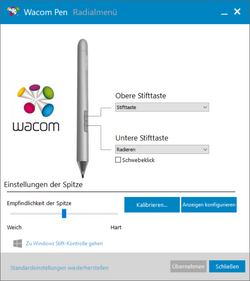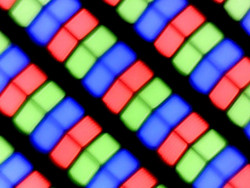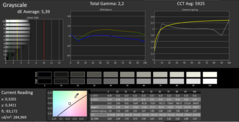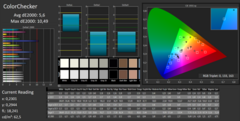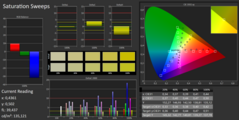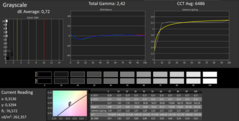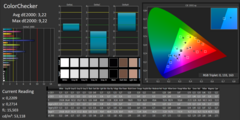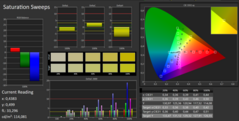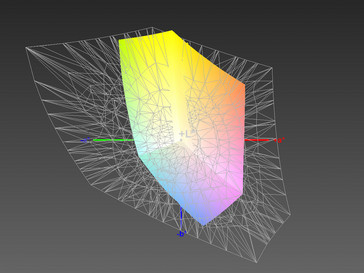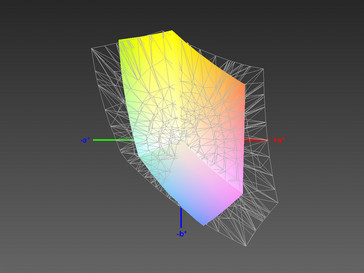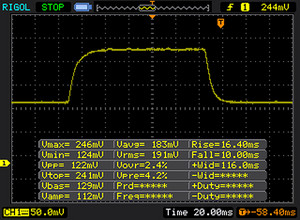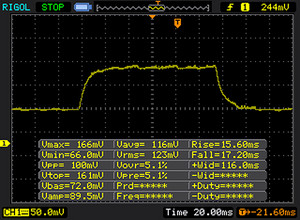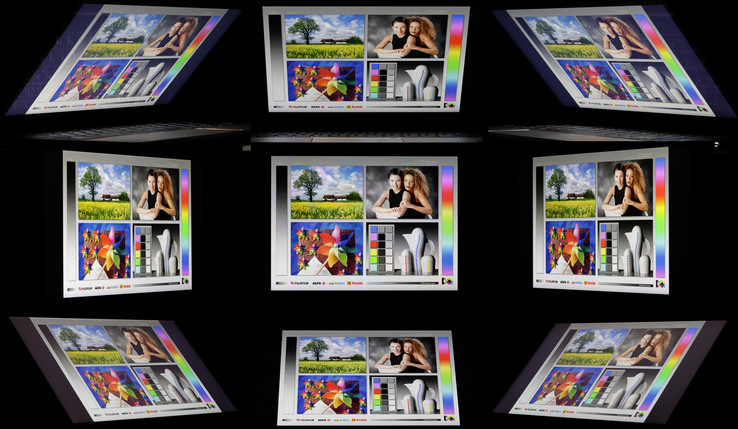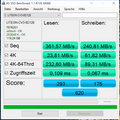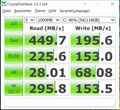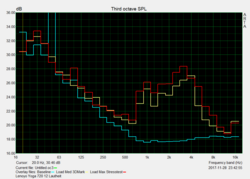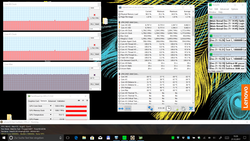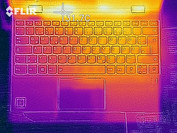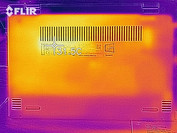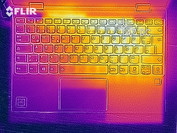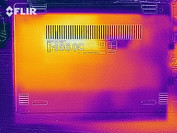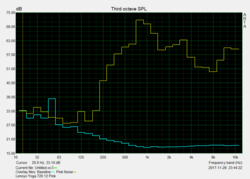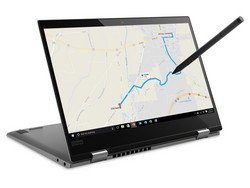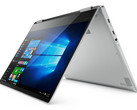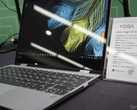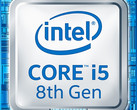Lenovo Yoga 720 12 (i5-7200U, 128 GB) Convertible Review

The new Lenovo Yoga 720 12 is a comparatively affordable convertible (2-in-1) with a compact 12.5-inch form factor. Our test model, the SKU 12IKB (81B5004T) is currently the only SKU in Lenovo's online shop for less than 900 Euros (~$1080). We have recently reviewed a very similar and just slightly larger Lenovo Yoga 720-13IKB, which managed a total score of 86%.
We found two additional and more expensive SKUs in other online stores. While our review unit is equipped with an Intel Core i5-7200U and a 128 GB SSD storage, the model with the designation 81B5001C features an i7-7500U and a 512 GB SSD storage as well as the SKU 81B5001B with the i5-7200U and a 256 GB SSD. All the other specifications such as 8 GB of RAM, 12.5-inch touchscreen (FHD, IPS), security features such as TPM and a fingerprint scanner are identical across all models. The operating system is always Windows 10 Home. The box includes an "Active Pen" as well as a mount. Lenovo offers two colors: Platinum and Iron Gray.
There are many convertibles with 12 or 13-inch screens, but many of them are much more expensive and cannot really be considered rivals for this review. We therefore selected some older models to stay in the price range as well as systems with detachable keyboards:
Case
The Lenovo Yoga 720 supports different operating modes (pictures below) thanks to the 360-degree hinges. The tablet mode is probably the most common, where the keyboard (automatically deactivated) is located at the bottom.
You cannot criticize Lenovo for cutting corners in terms of the case quality, despite the price point. The manufacturer advertises aluminum surfaces, but we cannot say how much metal there actually is. Nevertheless, the gleaming matte finish is very convincing, from both a visual as well as tactile standpoint. Fingerprints are not a big problem either. The design is similar to unibody subnotebooks and can almost be called generic; only the Lenovo logo on the lid, the rectangular hinges (also visible from the back), and the glossy surroundings of the touchpad as well as the fingerprint scanner are visual accents. The compact and elegant appearance is also supported by comparatively slim and black bezels.
The stability of the base unit is unfortunately not quite on par with the design. You can easily twist it with some force, which results in loud creaking sounds. This might be a result of the slim and light construction, but we have already reviewed comparable (and more expensive) convertibles with sturdier base units. The lid on the other hand leaves a much better impression and is mostly unaffected by pressure. It cannot be opened with one hand, but still wobbles a bit when the device is carried around (stand mode).
There is not much room for criticism in terms of build quality when you consider the limited number of chassis parts, but we still noticed some uneven gaps at the front corners and the housing of the display.
When we focus on the dimensions and the weight of the three 12.5-inch Lenovo Yoga 720, Lenovo Miix 520, and Microsoft Surface Pro devices, you have to differentiate the thickness and the footprint. While the Miix 520 occupies a bit more space on the desk compared to the other two models, the Surface Pro stands out thanks to its very slim construction and the lower weight (about 100g/~3.4 oz). Our test model is therefore right in the middle.
Connectivity
Many compact subnotebooks offer only a limited number of ports, but the Yoga 720 is especially sparse in this regard. Besides 1x USB 3.0 and 1x USB 31. Type-C (Gen.1) with DisplayPort, you only get the combined stereo jack. HDMI is missing, the same as Thunderbolt 3, a card reader, or a slot for a Kensington lock. Many users will probably have to use an HDMI adapter to use the DisplayPort of the USB-C port, which has to be purchased separately. All ports are located at the sides towards the rear, so you should not have any problems with collisions between cables/thumb drives and an external mouse.
Communication
A wired network connection can only be established via a USB adapter, so the new Yoga would have benefitted from a MIMO 2x2 adapter with a maximum transfer rate of 867 Mbps, despite the limited budget. Instead, Lenovo has only implemented the MIMO 1x1 module Qualcomm Atheros QCA9377 with a maximum speed of 433 Mbps. The comparison devices have an advantage in this section, although the Acer Spin 5 performs poorly when it receives data and even falls behind the test unit, despite its 2x2 module. We perform our measurements at a distance of one meter (~3 ft) from our reference router Linksys EA8500.
Security
As well as the modern TPM 2.0 chip, you also get a touch fingerprint scanner, which is easily set up via Windows Hello. It unlocks the notebook basically instantly and very reliably. However, other features such as hard drive encryption are not supported since the Lenovo Yoga 720 12 is not available with Windows 10 Pro.
Accessories
Except for the usual power adapter and some brochure, the box also contains the so called "Active Pen" stylus with an attachable mount.
Maintenance
Removing the bottom panel is no problem thanks to just four Torx screws, but it can void the warranty.
Warranty
Lenovo offers a two-year Bring-In warranty (depot), but offers additional upgrades.
Input Devices
Keyboard
The width of the grey keyboard is almost identical to a standard desktop keyboard, which allows decently sized keys with sufficient spacing. Except for things such as Pos1 and End, which are secondary functions on the arrow keys, the layout is also pretty standard. The keys are easy to see and flat, but pretty slippery and there is not much travel. The pressure point is firm and the keystroke is rather soft. You can only dent the keyboard with a lot of pressure.
As per usual, larger keys such as the space bar or return are louder, and prohibit the use in noise-sensitive environments. The two-stage and even illumination could have been brighter.
Touchpad
The touchpad is comparatively small due to the construction of the chassis. It is a completely smooth ClickPad without dedicated keys and provides good gliding capabilities, even with moist fingers. The surface is not perfectly integrated, so it appears a bit clattery and every contact creates a noise. The control over the cursor is very precise and even fast movements are well executed. Drag & Drop inputs via double tap work reliably, both via the ClickPad as well as the touchscreen. We also like the integrated mouse buttons thanks to the firm pressure point and the clear acoustic feedback. There is no dedicated drivers panel, so you are limited to gesture settings in the Windows 10 settings (up to four fingers).
Touchscreen
The 10-point capacitive touchscreen also convinces with flawless response and precision all the way into the corners. However, we recommend dry fingers, since moist fingers tend to get stuck on the surface. You can also use the provided Wacom stylus or Active Pen, respectively, which can also be configured (see picture).
Display
Most touchscreens have a glossy surface to facilitate cleaning. Lenovo calls the Yoga 720 12 "antiglare", and we actually did not have a lot of problems with reflections indoors as long as there were no light sources behind us. IPS ensures wide viewing angles, and the 1080p resolution on the 12.5-inch screen (165 PPI) creates crisp pictures. Lenovo does not offer any other display options.
The maximum luminance of 288 nits (274 nits on average) is not great and the Yoga is the darkest convertible within the comparison group, but this is not a big deal when you use it indoors. The Asus ZenBook Flip is noticeably brighter at 350 nits on average, but is also clearly beaten by the extremely bright Microsoft Surface Pro. We determine a brightness distribution of 87%, which is average, while the Surface Pro once again comes out ahead at 93%. Subjectively, the picture is still very even and there is no sign of backlight bleeding or clouding.
| |||||||||||||||||||||||||
Brightness Distribution: 87 %
Center on Battery: 285 cd/m²
Contrast: 1239:1 (Black: 0.23 cd/m²)
ΔE ColorChecker Calman: 5.6 | ∀{0.5-29.43 Ø4.77}
ΔE Greyscale Calman: 5.39 | ∀{0.09-98 Ø5}
64% sRGB (Argyll 1.6.3 3D)
41% AdobeRGB 1998 (Argyll 1.6.3 3D)
45.49% AdobeRGB 1998 (Argyll 3D)
64% sRGB (Argyll 3D)
44.05% Display P3 (Argyll 3D)
Gamma: 2.2
CCT: 5925 K
| Lenovo Yoga 720-12IKB AU Optronics AUO226D / B125HAN02.2, , 1920x1080, 12.5" | Acer Spin 5 SP513-52N-54SF LC133LF102, , 1920x1080, 13.3" | Asus Zenbook Flip UX360UAK-BB351T AU Optronics B133HAN02.7, , 1920x1080, 13.3" | Lenovo Miix 520-12IKB 81CG Unknown, , 1920x1200, 12.2" | HP Pavilion x360 13-u102ng LG Philips, , 1920x1080, 13.3" | Microsoft Surface Pro (2017) m3 LG Display LP123WQ112604, , 2736x1826, 12.3" | |
|---|---|---|---|---|---|---|
| Display | 53% | 44% | 44% | -9% | 55% | |
| Display P3 Coverage (%) | 44.05 | 69.8 58% | 64.1 46% | 64.4 46% | 39.43 -10% | 68.5 56% |
| sRGB Coverage (%) | 64 | 94.6 48% | 91.8 43% | 90.8 42% | 59.1 -8% | 99.2 55% |
| AdobeRGB 1998 Coverage (%) | 45.49 | 69.3 52% | 65.2 43% | 65.4 44% | 40.76 -10% | 70.1 54% |
| Response Times | -29% | -9% | -10% | -8% | -20% | |
| Response Time Grey 50% / Grey 80% * (ms) | 32 ? | 49 ? -53% | 36 ? -13% | 35.6 ? -11% | 38 ? -19% | 42 ? -31% |
| Response Time Black / White * (ms) | 26 ? | 27 ? -4% | 27 ? -4% | 28 ? -8% | 25 ? 4% | 28 ? -8% |
| PWM Frequency (Hz) | 1000 ? | 50 ? | 198.4 ? | |||
| Screen | 21% | 14% | -14% | -10% | 33% | |
| Brightness middle (cd/m²) | 285 | 295 4% | 368 29% | 348.8 22% | 277 -3% | 461 62% |
| Brightness (cd/m²) | 274 | 276 1% | 350 28% | 339 24% | 263 -4% | 444 62% |
| Brightness Distribution (%) | 87 | 88 1% | 87 0% | 87 0% | 88 1% | 93 7% |
| Black Level * (cd/m²) | 0.23 | 0.27 -17% | 0.29 -26% | 0.4 -74% | 0.31 -35% | 0.34 -48% |
| Contrast (:1) | 1239 | 1093 -12% | 1269 2% | 872 -30% | 894 -28% | 1356 9% |
| Colorchecker dE 2000 * | 5.6 | 2.97 47% | 5.26 6% | 7 -25% | 5.57 1% | 3.43 39% |
| Colorchecker dE 2000 max. * | 10.49 | 5.67 46% | 8.78 16% | 16.2 -54% | 13.6 -30% | 5.55 47% |
| Greyscale dE 2000 * | 5.39 | 3.12 42% | 5.87 -9% | 10.1 -87% | 4.56 15% | 3.08 43% |
| Gamma | 2.2 100% | 2.45 90% | 2.42 91% | 2.22 99% | 2.28 96% | 3.03 73% |
| CCT | 5925 110% | 6676 97% | 6998 93% | 9065 72% | 6648 98% | 7014 93% |
| Color Space (Percent of AdobeRGB 1998) (%) | 41 | 62 51% | 60 46% | 58.7 43% | 38 -7% | 64 56% |
| Color Space (Percent of sRGB) (%) | 64 | 94 47% | 92 44% | 90.9 42% | 59 -8% | 99 55% |
| Total Average (Program / Settings) | 15% /
21% | 16% /
17% | 7% /
-2% | -9% /
-9% | 23% /
31% |
* ... smaller is better
The Yoga has the lowest and therefore best black value amongst the competitors, so it is not surprising (but also not a matter of course) that we can enjoy pleasant and rich blacks. The black value also results in a very good contrast ratio despite the average luminance, and the Yoga can almost keep up with the brighter panels of the Microsoft and Asus systems.
Our Yoga 720 is not the ideal device for ambitious picture editing, not only because of the high color deviations ex-works as well as the low (and warm) color temperature, but mainly the small color gamut. Even the less demanding sRGB reference is covered by only 64%. The color accuracy can be improved with our calibrated profile, but this does not change the gamut. Graphics artists should have a look at the Surface Pro, at least if they do not have any professional ambitions.
The anti-reflective coating of the glossy screen also helps in the outdoors, but light sources such as the sky (picture on the left) are still a problem if you want to work. The picture on the right was taken with a wall behind us. You can still see some reflections on dark surfaces including the bezels, but not the brighter contents. It should therefore not be a problem to work in the shade.
Display Response Times
| ↔ Response Time Black to White | ||
|---|---|---|
| 26 ms ... rise ↗ and fall ↘ combined | ↗ 16 ms rise | |
| ↘ 10 ms fall | ||
| The screen shows relatively slow response rates in our tests and may be too slow for gamers. In comparison, all tested devices range from 0.1 (minimum) to 240 (maximum) ms. » 61 % of all devices are better. This means that the measured response time is worse than the average of all tested devices (20.2 ms). | ||
| ↔ Response Time 50% Grey to 80% Grey | ||
| 32 ms ... rise ↗ and fall ↘ combined | ↗ 15 ms rise | |
| ↘ 17 ms fall | ||
| The screen shows slow response rates in our tests and will be unsatisfactory for gamers. In comparison, all tested devices range from 0.165 (minimum) to 636 (maximum) ms. » 42 % of all devices are better. This means that the measured response time is similar to the average of all tested devices (31.6 ms). | ||
Screen Flickering / PWM (Pulse-Width Modulation)
| Screen flickering / PWM not detected | ||
In comparison: 53 % of all tested devices do not use PWM to dim the display. If PWM was detected, an average of 8091 (minimum: 5 - maximum: 343500) Hz was measured. | ||
Performance
Processor
The efficient ILV dual-core Intel Core i5-7200U (2x 2.5-3.1 GHz, Hyper Threading, 15W TDP) from Intel's first Kaby Lake generation is still in many new laptops, even though the more interesting Kaby Lake Refresh quad-cores like the i5-8250 (4x 1.6-3.4 GHz, Hyper-Threading, TDP 15 W) are already available. The i5-7200U is a comparatively inexpensive bread-and-butter CPU with more than sufficient performance for all office tasks. Even more demanding software is no problem as long as it does not benefit from four or more physical cores (like many modern games or video rendering).
The CPU is on the expected level in the first run of our Cinebench loop and the score only drops by 2-3% in the following tests. Sustained realistic workloads are executed with a very good, but not perfect Turbo utilization. The behavior does not change on battery power.
System Performance
Our PCMark system benchmarks below show that systems with the i5-8250U (up to 40% faster in CPU tests), such as the Lenovo Miix 520 and the Acer Spin 5, are not always better – our test model is actually ahead in some tests. Subjectively, the laptop is very fast, which can be expected from the components. Multi-tasking is more limited by the memory, but applications and the OS launch very quickly, even though not as quickly as on a gaming system with the i7-7700HQ, 16 GB of RAM, and NVMe-SSD, for example.
| PCMark 8 Home Score Accelerated v2 | 3699 points | |
| PCMark 8 Work Score Accelerated v2 | 4442 points | |
Help | ||
Storage Devices
We are a bit surprised by the benchmarks, because it seems that the SSD tool AS SSD does not really like the Lite-On SSD. Most results show lower transfer rates compared to the CrystalDiskMark 3.0 benchmark.
About 362 MB/s sequential read and just 241 MB/s sequential write are clearly below the SATA-III limit at around 500 MB/s, which is usually the performance level of these SSDs. The transfer rate for small data blocks, which is important for OS and application launches, is also low at just 24 MB/s. We expect at least 30 MB/s from a modern SSD. The low SSD performance affects the total score, which is at the bottom of our database for SATA-III SSDs. However, the drive is still faster than a conventional HDD.
| Lenovo Yoga 720-12IKB Liteonit CV3-8D128 | Acer Spin 5 SP513-52N-54SF Micron 1100 MTFDDAV256TBN | Asus Zenbook Flip UX360UAK-BB351T Micron SSD 1100 (MTFDDAV256TBN) | HP Pavilion x360 13-u102ng HGST Travelstar 5K1000 HTS541010A7E630 | Microsoft Surface Pro (2017) m3 Samsung PM971 KUS020203M | |
|---|---|---|---|---|---|
| CrystalDiskMark 3.0 | 52% | 38% | -86% | 59% | |
| Read Seq (MB/s) | 449.7 | 462.7 3% | 478.4 6% | 104.8 -77% | 691 54% |
| Write Seq (MB/s) | 195.6 | 439.9 125% | 419.9 115% | 91 -53% | 670 243% |
| Read 512 (MB/s) | 225.6 | 325.2 44% | 351.7 56% | 20.67 -91% | 261.1 16% |
| Write 512 (MB/s) | 153 | 361.9 137% | 294.2 92% | 45.05 -71% | 241 58% |
| Read 4k (MB/s) | 28.01 | 27.52 -2% | 24 -14% | 0.215 -99% | 40.11 43% |
| Write 4k (MB/s) | 68.1 | 91.6 35% | 87 28% | 1.037 -98% | 98.8 45% |
| Read 4k QD32 (MB/s) | 295.8 | 247.3 -16% | 199.3 -33% | 0.968 -100% | 301.8 2% |
| Write 4k QD32 (MB/s) | 153.5 | 292 90% | 232.4 51% | 1.09 -99% | 172 12% |
GPU Performance
The Intel HD 620 is the integrated GPU of many modern ULV chips from Intel with a 15W TDP rating. It is not equipped with its own VRAM, which limits the 3D performance. The GPU runs at up to 1000 MHz and benefits from the fast dual-channel DDR4 RAM configuration in the Yoga, which is in the upper third of the HD 620 performance range. Video enthusiasts will be happy about the improved video decoder with support for H.265/HEVC and Google's VP9. The Fire Strike score is not reduced on battery power.
| 3DMark | |
| 1280x720 Cloud Gate Standard Graphics | |
| Acer Spin 5 SP513-52N-54SF | |
| Lenovo Miix 520-12IKB 81CG | |
| Lenovo Yoga 720-12IKB | |
| HP Pavilion x360 13-u102ng | |
| Microsoft Surface Pro (2017) m3 | |
| 1920x1080 Fire Strike Graphics | |
| Acer Spin 5 SP513-52N-54SF | |
| Lenovo Miix 520-12IKB 81CG | |
| Lenovo Yoga 720-12IKB | |
| HP Pavilion x360 13-u102ng | |
| Microsoft Surface Pro (2017) m3 | |
| 3DMark 11 Performance | 1658 points | |
| 3DMark Cloud Gate Standard Score | 6488 points | |
| 3DMark Fire Strike Score | 931 points | |
Help | ||
Gaming Performance
Our little table below shows that you can pretty much forget modern 3D titles, because they will not run smoothly even at low settings in 1024x768 or 1280x720 pixels. Games with isometric presentations such as “StarCraft III” or “Diablo III” on the other hand will often run at medium or even high settings. The FPS numbers of “Farming Simulator 17” are missing because the game (or more precisely the drivers) only produced pink fragments when we launched it. You can expect up to 60 (low) or 44 FPS (medium), respectively.
| low | med. | high | ultra | |
|---|---|---|---|---|
| The Witcher 3 (2015) | 12.8 | |||
| Rise of the Tomb Raider (2016) | 19.2 | |||
| Farming Simulator 17 (2016) | 0 severe graphical problems |
Emissions
System Noise
Thanks to its very subtle acoustic behavior, the Yoga is also a good choice for noise-sensitive users. The fan is deactivated while idling and during short peak load. It will start spinning after a few seconds when we perform the browser benchmark Kraken 1.1, but quickly stops when the benchmark is done. You can hardly hear the fan at low RPM levels in a quiet single office.
The fan seamlessly increases its speed during the stress test (Prime95 & FurMark), but the maximum noise is a rather subtle murmur without annoying noises. Still, the maximum noise level is on par with other laptops under light workloads, which deserves special praise.
Noise level
| Idle |
| 30.3 / 30.3 / 30.3 dB(A) |
| Load |
| 36 / 37.4 dB(A) |
 | ||
30 dB silent 40 dB(A) audible 50 dB(A) loud |
||
min: | ||
Temperature
The idle surface temperatures of the Lenovo Yoga 720-12IKB exceed the ambient temperature by only a few degrees. High workloads result in up to 43 °C (~109 °F) on both sides, but this only matters when you really stress the system and hold the device in your hands (tablet mode) or use it on the lap. The important area around the palm rests on the other hand just warms up to 29 °C (~84 °F).
The processor started our stress test with Prime95 + FurMark at 3.1 GHz but quickly leveled off at 1.7-1.9 GHz after a few minutes. The lowest value was 1.6 GHz after about ten minutes, which is steady over the course of the stress test, and the temperature was just 69 °C (~156 °F). The base clock of the processor is 2.5 GHz, so there is significant throttling in this extreme scenario. However, you do not have to expect performance limitations during regular office or even more demanding tasks. The clock of the Intel HD Graphics 620 is hardly affected by the test and is steady at 1000 MHz most of the time with occasional drops to 960 MHz later in the test.
(±) The maximum temperature on the upper side is 42.1 °C / 108 F, compared to the average of 35.4 °C / 96 F, ranging from 19.6 to 60 °C for the class Convertible.
(±) The bottom heats up to a maximum of 43 °C / 109 F, compared to the average of 36.8 °C / 98 F
(+) In idle usage, the average temperature for the upper side is 23.8 °C / 75 F, compared to the device average of 30.3 °C / 87 F.
(+) The palmrests and touchpad are cooler than skin temperature with a maximum of 29 °C / 84.2 F and are therefore cool to the touch.
(±) The average temperature of the palmrest area of similar devices was 27.9 °C / 82.2 F (-1.1 °C / -2 F).
Speakers
The maximum volume of the two bottom-firing speakers is only sufficient for smaller rooms, but there can still be distortions when you listen to some Pop music. There is a focus on medium tones, and the result sounds flat and muddy without any dynamic range. At least, it is not shrill and does not annoy with volume fluctuations either. Voices are easy to understand. All in all, the sound system is below average, but still decent for an office laptop.
Lenovo Yoga 720-12IKB audio analysis
(-) | not very loud speakers (71.8 dB)
Bass 100 - 315 Hz
(-) | nearly no bass - on average 20.5% lower than median
(±) | linearity of bass is average (14% delta to prev. frequency)
Mids 400 - 2000 Hz
(±) | higher mids - on average 6% higher than median
(±) | linearity of mids is average (10.7% delta to prev. frequency)
Highs 2 - 16 kHz
(+) | balanced highs - only 4.7% away from median
(±) | linearity of highs is average (7.9% delta to prev. frequency)
Overall 100 - 16.000 Hz
(±) | linearity of overall sound is average (25.8% difference to median)
Compared to same class
» 79% of all tested devices in this class were better, 4% similar, 17% worse
» The best had a delta of 6%, average was 20%, worst was 57%
Compared to all devices tested
» 79% of all tested devices were better, 4% similar, 17% worse
» The best had a delta of 4%, average was 24%, worst was 134%
Asus Zenbook Flip UX360UAK-BB351T audio analysis
(-) | not very loud speakers (63 dB)
Bass 100 - 315 Hz
(±) | reduced bass - on average 10.1% lower than median
(±) | linearity of bass is average (7.4% delta to prev. frequency)
Mids 400 - 2000 Hz
(+) | balanced mids - only 2.6% away from median
(+) | mids are linear (2.8% delta to prev. frequency)
Highs 2 - 16 kHz
(+) | balanced highs - only 2.6% away from median
(+) | highs are linear (3.1% delta to prev. frequency)
Overall 100 - 16.000 Hz
(+) | overall sound is linear (14.4% difference to median)
Compared to same class
» 21% of all tested devices in this class were better, 4% similar, 75% worse
» The best had a delta of 6%, average was 20%, worst was 57%
Compared to all devices tested
» 17% of all tested devices were better, 4% similar, 79% worse
» The best had a delta of 4%, average was 24%, worst was 134%
Microsoft Surface Pro (2017) m3 audio analysis
(-) | not very loud speakers (68.8 dB)
Bass 100 - 315 Hz
(±) | reduced bass - on average 12.9% lower than median
(±) | linearity of bass is average (10.5% delta to prev. frequency)
Mids 400 - 2000 Hz
(+) | balanced mids - only 3.7% away from median
(±) | linearity of mids is average (9.6% delta to prev. frequency)
Highs 2 - 16 kHz
(+) | balanced highs - only 4.1% away from median
(±) | linearity of highs is average (8.6% delta to prev. frequency)
Overall 100 - 16.000 Hz
(±) | linearity of overall sound is average (19.1% difference to median)
Compared to same class
» 45% of all tested devices in this class were better, 7% similar, 49% worse
» The best had a delta of 6%, average was 20%, worst was 57%
Compared to all devices tested
» 45% of all tested devices were better, 7% similar, 48% worse
» The best had a delta of 4%, average was 24%, worst was 134%
Frequency Comparison (Checkboxes select/deselectable!)
Energy Management
Power Consumption
The Lenovo Yoga 720-12IKB is the most efficient device in our comparison group and can even beat the less powerful MS Surface Pro in many tests, the latter is only more efficient under load. However, the scenarios Idle min and Idle avg. are more important for business tasks. The provided 45W power adapter is sufficient.
| Off / Standby | |
| Idle | |
| Load |
|
Key:
min: | |
| Lenovo Yoga 720-12IKB i5-7200U, HD Graphics 620, Liteonit CV3-8D128, IPS, 1920x1080, 12.5" | Acer Spin 5 SP513-52N-54SF i5-8250U, UHD Graphics 620, Micron 1100 MTFDDAV256TBN, IPS, 1920x1080, 13.3" | Asus Zenbook Flip UX360UAK-BB351T i5-7200U, HD Graphics 620, Micron SSD 1100 (MTFDDAV256TBN), IPS, 1920x1080, 13.3" | Lenovo Miix 520-12IKB 81CG i5-8250U, UHD Graphics 620, Samsung PM961 MZVLW256HEHP, IPS, 1920x1200, 12.2" | HP Pavilion x360 13-u102ng i5-7200U, HD Graphics 620, HGST Travelstar 5K1000 HTS541010A7E630, IPS, 1920x1080, 13.3" | Microsoft Surface Pro (2017) m3 m3-7Y30, HD Graphics 615, Samsung PM971 KUS020203M, IPS, 2736x1826, 12.3" | |
|---|---|---|---|---|---|---|
| Power Consumption | -15% | -16% | -44% | -13% | -7% | |
| Idle Minimum * (Watt) | 3.7 | 3.9 -5% | 4.2 -14% | 5.5 -49% | 4.7 -27% | 3.1 16% |
| Idle Average * (Watt) | 5.7 | 8.2 -44% | 7.4 -30% | 8.3 -46% | 7.2 -26% | 8.8 -54% |
| Idle Maximum * (Watt) | 6.9 | 8.8 -28% | 8.6 -25% | 11.5 -67% | 7.9 -14% | 9.8 -42% |
| Load Average * (Watt) | 29.6 | 28.5 4% | 32 -8% | 38.3 -29% | 30 -1% | 22.7 23% |
| Load Maximum * (Watt) | 29.4 | 30.7 -4% | 30.2 -3% | 37.7 -28% | 29 1% | 23.6 20% |
* ... smaller is better
Battery Runtime
Only the convertibles Lenovo Miix 520 (+5.6%) and HP Pavilion x360 (+13.9%) have similarly sized batteries and are suited for a direct comparison. Despite their bigger batteries, however, they fall behind by 3 up to 26%. Our realistic WLAN test at an adjusted luminance of 150 nits runs for 6 hours on the Yoga. A result between 8-10 hours would be better to cover a full business day. The Surface Pro even lasted more than 11 hours.
| Lenovo Yoga 720-12IKB i5-7200U, HD Graphics 620, 36 Wh | Acer Spin 5 SP513-52N-54SF i5-8250U, UHD Graphics 620, 53.9 Wh | Asus Zenbook Flip UX360UAK-BB351T i5-7200U, HD Graphics 620, 57 Wh | Lenovo Miix 520-12IKB 81CG i5-8250U, UHD Graphics 620, 38 Wh | HP Pavilion x360 13-u102ng i5-7200U, HD Graphics 620, 41 Wh | Microsoft Surface Pro (2017) m3 m3-7Y30, HD Graphics 615, 45 Wh | |
|---|---|---|---|---|---|---|
| Battery runtime | 38% | 95% | -9% | -12% | 82% | |
| Reader / Idle (h) | 11.5 | 12.3 7% | 9.3 -19% | 15.6 36% | ||
| WiFi v1.3 (h) | 6 | 8.3 38% | 11.7 95% | 5.6 -7% | 5.4 -10% | 11.4 90% |
| Load (h) | 1.5 | 1.1 -27% | 1.4 -7% | 3.3 120% | ||
| H.264 (h) | 5.3 | 11.1 |
Verdict
Pros
Cons
Office users will notice two drawbacks on the well-designed Lenovo Yoga 720-12IKB – the comparatively slow WLAN module and, more importantly, the runtimes that cannot cover a full business day on the go. The display choice is very good except for any serious picture editing, and the slow SSD benchmark results do not affect the good system performance. Limited port variety is common among compact convertibles, so we can hardly criticize the Yoga here.
The stability of the case is not perfect, but it is still a successful chassis with a nice design and good build quality. The provided Active Pen, the decent input devices including touchscreen as well as the efficient, cool, and very quiet operation are other advantages.
The compact and versatile convertible Lenovo Yoga 720 12 is affordable and meets almost all requirements for mobile business users. The only real drawback is the limited stamina on battery power.
All in all, we can recommend the test model.
Lenovo Yoga 720-12IKB
- 01/04/2018 v6 (old)
Sven Kloevekorn




